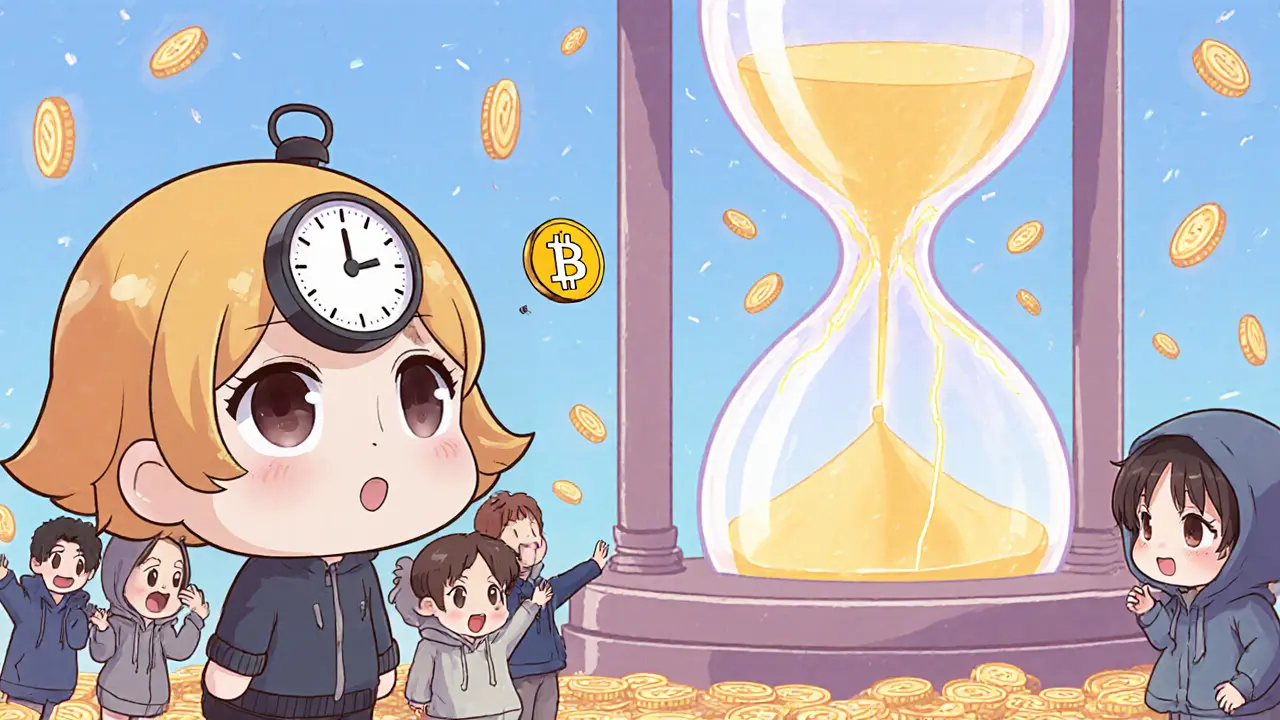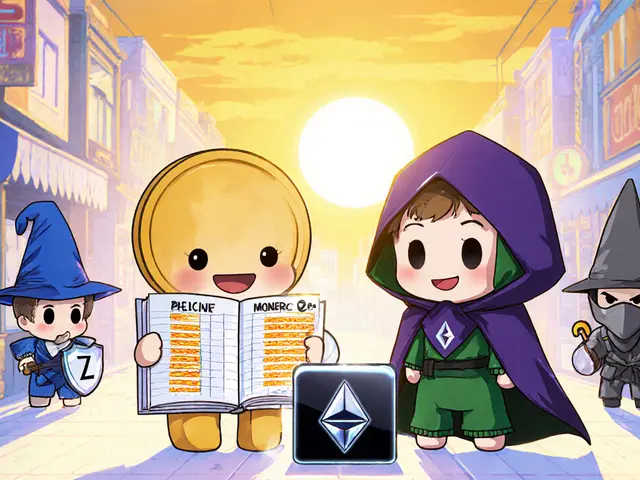Bitcoin Transaction Speed Estimator
Estimate Your Transaction Time
Enter your fee rate (in satoshis per byte) to see expected confirmation time based on current network conditions.
Estimated Confirmation Time
How This Works
Based on Bitcoin's 10-minute block time:
- High fee (25+ sat/vB): Confirm in 1-10 minutes
- Medium fee (10-24 sat/vB): Confirm in 10-30 minutes
- Low fee (1-9 sat/vB): Confirm in 30-60+ minutes
Remember: Confirmation time depends on network congestion. When the mempool is full, miners prioritize higher fees.
Ever wonder why your Bitcoin transaction takes 10 minutes-or sometimes an hour-to confirm? It’s not a glitch. It’s by design. The secret lies in something called block time, and it’s one of the most important-but often misunderstood-parts of how blockchains actually work.
What Block Time Really Means
Block time is the average time it takes for a new block to be added to the blockchain. In Bitcoin, that’s about 10 minutes. That means, on average, every 10 minutes, a group of recent transactions gets bundled into a block, verified by miners, and added to the chain. Once your transaction is in that block, it’s confirmed. This isn’t a random number. Satoshi Nakamoto picked 10 minutes after testing different intervals. Too fast, and the network gets messy. Too slow, and users get frustrated. Ten minutes struck a balance: enough time for blocks to spread across the globe, but fast enough to keep payments moving. But here’s the catch: your transaction doesn’t get processed the moment you hit send. It waits in a queue-called the mempool-until a miner picks it up and includes it in the next block. If the network is busy, that queue gets long. And if you didn’t pay enough in fees, your transaction might sit there for hours.Why Block Time Limits Transaction Speed
Bitcoin can only fit about 1 megabyte of data in each block. With average transaction sizes around 250 bytes, that’s roughly 4,000 transactions per block. At 10 minutes per block, that gives you about 7 transactions per second (TPS). Compare that to Visa, which handles 1,700 TPS on average, and you can see why Bitcoin isn’t built for buying coffee. It’s not just about size. Block time is the bottleneck. Even if you doubled the block size, you’d still be capped at 6 transactions per minute unless you change the timing. That’s why simply making blocks bigger doesn’t solve the speed problem-it just pushes it down the road. The 10-minute block time also forces miners to wait for the previous block to propagate before starting work on the next one. If blocks came faster-say, every 30 seconds-miners might start building on an outdated version of the chain. That leads to orphaned blocks, wasted work, and a higher risk of double-spending. Bitcoin’s 10-minute rule helps prevent that chaos.The Trade-Off: Speed vs. Security
Some blockchains, like Solana or Polygon, use block times under 1 second. They’re fast. But they’re also more centralized. Why? Because faster blocks mean nodes need better hardware and faster internet to stay synced. That pushes smaller miners and node operators out. Centralization weakens security. Bitcoin’s 10-minute block time is a shield. It gives the network time to reach consensus across thousands of nodes spread across continents. It makes it harder for any single group to control the chain. That’s why Bitcoin is still the most secure blockchain in existence-despite its slow speed. This is the blockchain trilemma in action: you can only pick two out of three-decentralization, security, scalability. Bitcoin chose security and decentralization. Speed? That’s not the priority.
How Confirmation Counts Change Settlement Time
Even after your transaction is in a block, it’s not always “final.” Most services ask for multiple confirmations before considering a payment complete. One confirmation means your transaction is in the blockchain. Two? Better. Six? That’s the gold standard for Bitcoin. Why six? Because after six blocks, the chance of a chain reorganization (a rare event where the blockchain temporarily splits and one side gets abandoned) drops to near zero. Six blocks at 10 minutes each? That’s 60 minutes. So even if your transaction gets mined in 5 minutes, you might still wait an hour before your exchange or wallet accepts it as settled. For small payments-like sending $5 to a friend-one confirmation might be enough. But for buying a car or transferring $10,000? Six confirmations aren’t optional. They’re essential.What Happens When the Network Gets Busy
When demand spikes-like during a crypto bull run or a big NFT drop-the mempool fills up. Miners prioritize transactions with the highest fees. If you paid the default fee, your transaction might take hours. If you paid $10 in fees, it might confirm in 5 minutes. This isn’t a flaw. It’s a market. Bitcoin’s fee system is a bidding war for limited block space. The 10-minute block time creates scarcity. And scarcity drives price. In 2021, during Bitcoin’s peak, fees hit over $60 per transaction. People paid that because they had no choice. The system worked exactly as designed: those who needed speed paid for it. Those who didn’t, waited.




Sammy Krigs
November 1, 2025 AT 18:05block time is just a lie the miners tell us so we dont notice theyre hoarding all the tx fees
Jeremy Jaramillo
November 3, 2025 AT 09:23This is one of the clearest explanations I've read on why Bitcoin works the way it does. Not every system needs to be fast to be valuable. Security and decentralization matter more than speed when you're storing life savings.
Bruce Bynum
November 4, 2025 AT 14:34Bitcoin isn't meant for coffee. It's meant to outlast governments. That's the real win.
Matthew Affrunti
November 6, 2025 AT 02:47Love how this breaks it down without jargon. Feels like someone finally explained why my transfer took 45 minutes and I didn't lose my mind.
mark Hayes
November 6, 2025 AT 05:3110 minutes is the blockchain equivalent of a deep breath before diving in
slow but steady wins the race
Derek Hardman
November 7, 2025 AT 11:19The comparison to Visa is misleading. Bitcoin isn't a payment processor-it's a settlement layer. The distinction is fundamental and often ignored.
Phyllis Nordquist
November 8, 2025 AT 01:15It is worth noting that the 10-minute block time was empirically derived through simulation and remains optimal under current network conditions. Any deviation introduces measurable risks to consensus stability, particularly in the presence of variable latency across global node distributions. This is not arbitrary-it is mathematically grounded.
Eric Redman
November 9, 2025 AT 04:41they say its secure but really its just slow because they cant figure out how to make it faster without breaking the whole thing
Jason Coe
November 10, 2025 AT 12:26I used to think Bitcoin was broken until I realized it wasn't designed for me. I'm not paying $60 to send $5 to my buddy. But when I moved $20k? Took 12 minutes, zero chargebacks, zero middlemen. That's when it clicked. Speed isn't the point-finality is. And once you get that, you stop complaining about the 10 minutes.
Brett Benton
November 10, 2025 AT 14:11Just got back from Bali and saw a street vendor accept Bitcoin via Lightning. No waiting. No fees. He didn't even know what blockchain meant. That's the future-Bitcoin as the backbone, everything else as the apps on top.
David Roberts
November 12, 2025 AT 00:46block time is a smokescreen for the mining oligarchy. the 10 minute wait? designed to keep small players out. they want you to use lightning or sidechains so they can monetize the flow. it's all a game of control disguised as decentralization.
Monty Tran
November 12, 2025 AT 17:09Lightning Network is the real innovation. Bitcoin mainnet is just a vault. Stop pretending it's a bank.
Beth Devine
November 14, 2025 AT 01:44For anyone new to crypto, this is a great starting point. Don't compare Bitcoin to Visa. Compare it to gold. Gold doesn't move fast either, but it's still worth holding.
Brian McElfresh
November 14, 2025 AT 21:05they said 10 minutes was for security but really its so the fed can track your transactions through the miners. you think its decentralized? think again. the block time is a backdoor.
Hanna Kruizinga
November 16, 2025 AT 04:28Why do we even care? Just use USDT on Solana. Done.
David James
November 17, 2025 AT 20:26Good breakdown. I always tell my friends Bitcoin is like a safe deposit box. You don't go in every day. You go in when it matters.
Shaunn Graves
November 18, 2025 AT 22:48So you're telling me the entire crypto community is just pretending Bitcoin is money when everyone knows it's not? That's not innovation. That's delusion.
Jessica Hulst
November 19, 2025 AT 01:17It's funny how we romanticize Bitcoin's slowness as "security" while ignoring that the real security is in the code, not the clock.
But then again, we also call it "digital gold" while using it to send $2 to a friend who owes us for pizza.
Maybe the problem isn't block time-it's our cognitive dissonance.
Edgerton Trowbridge
November 19, 2025 AT 03:46It is imperative to recognize that the architectural constraints imposed by the Nakamoto consensus mechanism are not merely technical limitations but rather intentional design decisions rooted in game-theoretic stability. The 10-minute block interval facilitates global synchronization among nodes with heterogeneous network latencies, thereby minimizing the probability of chain forks and ensuring that the economic incentives for honest mining remain robust. Any attempt to accelerate this interval without a corresponding increase in network bandwidth and computational uniformity would introduce significant vulnerabilities to selfish mining attacks and orphaned block proliferation. Consequently, the persistence of this parameter is not an artifact of historical accident but a deliberate safeguard against systemic failure.
naveen kumar
November 19, 2025 AT 21:3710 minutes? That's just what they want you to believe. The real reason is that the block time is manually adjusted by a secret committee in the basement of the Federal Reserve. Every time Bitcoin's price goes up, they slow it down to create artificial scarcity. The miners? Just puppets. The code? A front. You're being played.